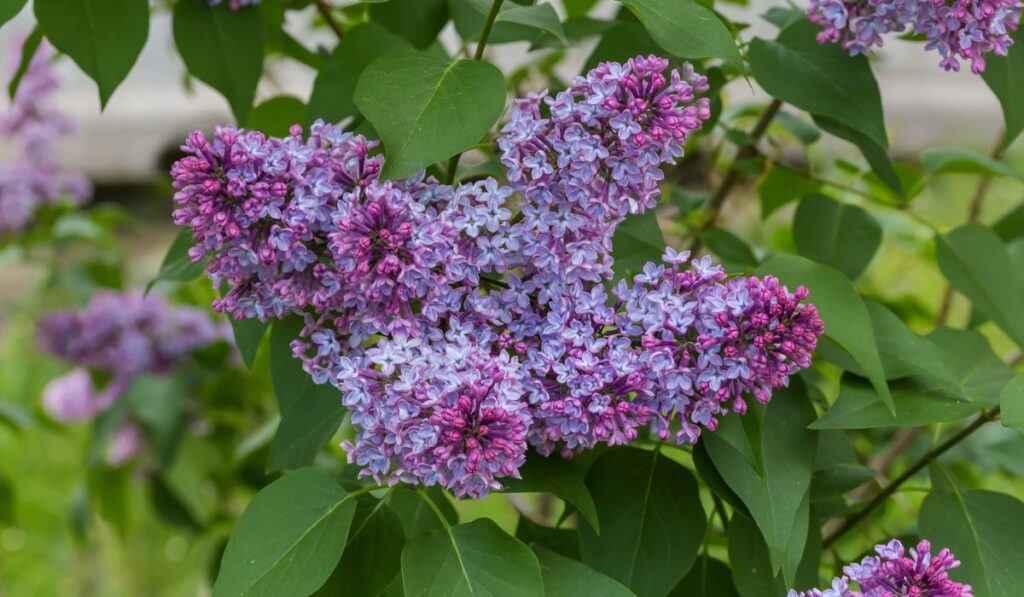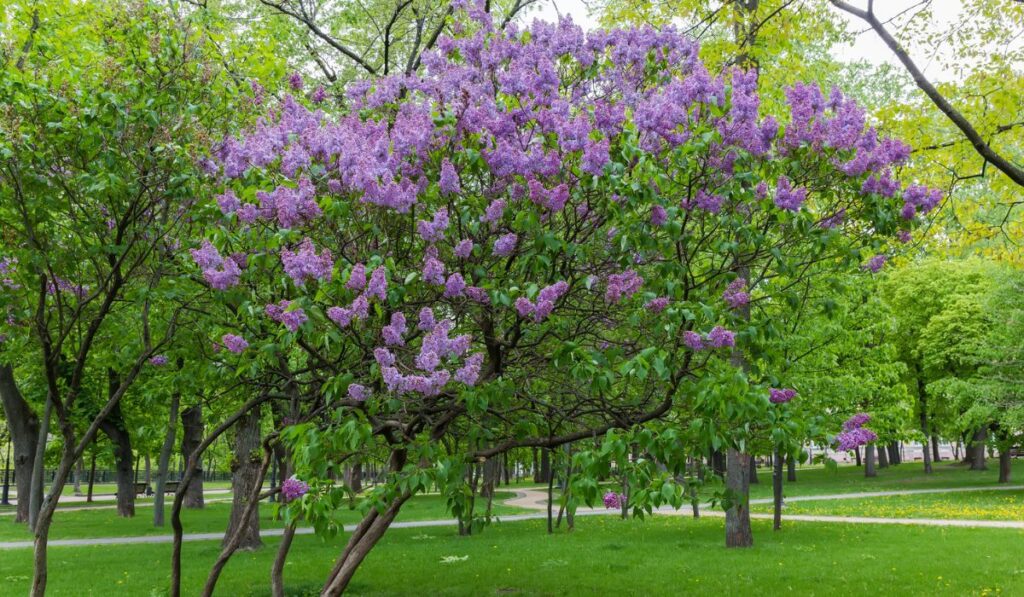Lilacs — the classic purple flowering shrub — have been gracing gardens for centuries. Though their old-fashioned reputation might make you think they’re difficult to grow, nothing could be further from the truth! Lilacs are one of the toughest and most reliable shrubs out there, making them perfect for beginner gardeners. So, when’s the best time to plant lilacs?
The best time of year to plant lilacs is in the fall, about 6-8 weeks before the first frost. This gives the roots time to establish themselves in the ground ahead of the harsh winter weather. However, with a little extra care, you can also plant lilacs in the spring or even in summer.
Lilacs are undoubtedly one of the most beautiful and fragrant shrubs you can grow in your garden. So, what are you waiting for? Let’s take a closer look at how to choose and plant your own lilacs.
Best Time of Year for Planting Lilacs

The best time to plant lilacs is in the fall, about 6-8 weeks before the first frost. This way, the new plants spend the winter getting acclimated to their new homes and have a head start on growth when spring comes around.
The next best time to plant lilacs is in the early spring, just as the weather is starting to warm up. Make sure all the danger of frost has passed in your area and that the soil temperature is at least 50°F (10°C) before planting.
Usually, bare root lilacs (on Amazon) are available during this time. Given the right conditions, they’ll have no trouble taking off and catching up to fall-planted shrubs.
Technically, you can plant lilacs at any time of year — even in the middle of summer. But it’s a bit of a gamble, as the heat and stress of transplanting can shock new plants. So, if you choose to plant during the summer, give your lilacs plenty of water and ensure the roots don’t dry out.
Choosing Your Lilac
The classic lilac is Syringa vulgaris, a purple-flowered shrub that blooms in late spring. However, there are 12 different species and hundreds of varieties of lilacs to choose from. You can find lilacs in nearly every color imaginable, from classic purples and whites to pinks, reds, and even yellows.
Lilacs are mainly classified on the basis of height and growth habits, with the following categories:
Dwarf Shrubs
These lilacs remain under 6 feet and grow into compact, rounded shrubs. Dwarf varieties are tolerant to common diseases and bloom multiple times throughout the season. However, the flowers are small and aren’t as fragrant as other varieties. Some common dwarf varieties include ‘Miss Kim,’ ‘Palibin,’ and ‘Bloomerang.’
Intermediate Shrubs
These ones grow 6-12 feet tall with a similar spread. They produce large, showy flowers in late spring and early summer. They’re also fairly tolerant to common diseases like powdery mildew. Some popular intermediate varieties include ‘Sensation,’ ‘Beauty of Moscow,’ and ‘Monge.’
Lilac Trees
Lilac trees can grow more than 15 feet tall with a single trunk and an umbrella-shaped canopy of branches. They produce the largest flowers in a cream shade and have a strong scent. They bloom right after the leaves appear in spring. Some of the most popular lilac trees include ‘Common lilac,’ ‘Japanese Lilac tree,’ and ‘Pekin lilac tree.’
All the Lilacs are hardy in USDA zone 3-7 and can tolerate cold winters and hot summers. A few more-tolerant varieties, like Cutleaf lilac and Angel White, can survive further south, in zone 8 and 9. When choosing a lilac for your garden, make sure to pick a variety appropriate for your USDA zone.
You should also consider the size of the mature plant and the amount of space you have in your garden. The shrub varieties are great for small gardens or as foundation plants in front of your house. You can also make hedges out of these. But if you have the space, go for a lilac tree — they make stunning backdrops and focal points in any garden.
Where to Plant Your Lilacs
Lilacs need full sun to thrive; they grow best in an area that gets at least 6 hours of direct sunlight daily. Any less and the plants will become leggy and produce fewer flowers.
They also prefer rich, well-draining soil with a neutral to slightly alkaline pH (6.0-7.0). Lilacs don’t appreciate wet feet at all, and they will quickly succumb to root rot if the soil doesn’t drain well. You can improve drainage by mixing sand and organic matter like compost or peat moss (on Amazon) if you have heavy clay soil.
Another important aspect is space. Lilacs can grow quite large, especially the bigger shrubs and tree varieties. The roots take about half the width of the plant, but they aren’t invasive, so you can plant them quite close to a walkway or house foundation. However, makes sure you leave enough space for the plant to reach its full potential.
How Long Do Lilacs Bloom?
Lilacs typically bloom for 2-3 weeks in late spring, with the peak usually occurring around Mother’s Day. But several varieties of early and late bloomers can give your garden color all season long.
Early bloomers include ‘Pocahontas,’ ‘Charles joy,’ and ‘Miss Kim.’ They produce flowers in early to mid-spring, about 1-2 weeks before common lilacs set their blooms.
Late bloomers include ‘Donald Wayman,’ Bloomerang,’ and ‘President Grevy.’ Most of these are rebloomers, which means they first bloom in late spring and then again in early summer. Late bloomers can continue flowering until the end of June if you deadhead the spent blooms regularly.
However, Common Lilac (Syringa vulgaris) remains the longest blooming variety, with a single flush in late spring.
Why Plant Lilacs?

Lilacs may be old-fashioned, but they’re still one of the most beloved shrubs around. And there are several reasons for that:
- The Fragrance: Lilacs have a strong, sweet fragrance that can fill an entire garden. Several cultivars are even used in making perfumes and soaps (on Amazon). An early morning walk through a lilac bush is an experience you won’t forget any time soon.
- Toughness: Lilacs are incredibly tough and resilient plants. They can tolerate most pests and diseases, as well as harsh winters. You can pretty much plant and forget about them, and they’ll still bloom beautifully year after year.
- Reliability: You can count on lilacs to bloom every spring, no matter what the weather is like. They are one of the first shrubs to flower in the season, and the flowers last for weeks.
- Long-Lived: With proper care, lilacs can live for decades — some varieties last even 50-80 years! So once you plant them, you can enjoy their beauty for many years to come.
- Variety: Lilacs come in all shapes and sizes, from small bushes to large trees. The flowers also come in various colors, from traditional purple and white to pink and blue. Single and double-tier varieties are also available.
- Low-Maintenance: Lilacs don’t need much care to thrive. Trees need a light pruning once a year after flowering, and shrubs can be chopped to shape if they become leggy. The watering needs are also very low — once established, they can survive on rains or weekly watering during dry spells.
- Attracts Pollinators: Lilacs are very attractive to bees, butterflies, and other pollinators. Especially common lilacs are known to be one of the favorites of bees. So if you’re looking to attract more wildlife to your garden, plant some lilacs.
As you can see, there are many reasons to plant lilacs in your garden. But the best reason of all is that they’re just so darn beautiful!
Nothing says spring like a lilac bush in full bloom. So if you’re looking for a plant that’s easy to care for, long-lived, and reliable, look no further than the majestic lilac.
